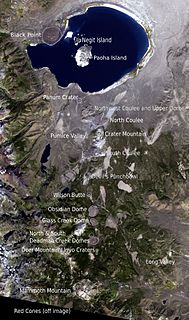
The Mono–Inyo Craters are a volcanic chain of craters, domes and lava flows in Mono County, Eastern California. The chain stretches 25 miles (40 km) from the northwest shore of Mono Lake to the south of Mammoth Mountain. The Mono Lake Volcanic Field forms the northernmost part of the chain and consists of two volcanic islands in the lake and one cinder cone volcano on its northwest shore. Most of the Mono Craters, which make up the bulk of the northern part of the Mono–Inyo chain, are phreatic volcanoes that have since been either plugged or over-topped by rhyolite domes and lava flows. The Inyo volcanic chain form much of the southern part of the chain and consist of phreatic explosion pits, and rhyolitic lava flows and domes. The southernmost part of the chain consists of fumaroles and explosion pits on Mammoth Mountain and a set of cinder cones south of the mountain; the latter are called the Red Cones.

Lupinus arboreus, the yellow bush lupine (US) or tree lupin (UK), is a species of flowering plant in the legume family Fabaceae.

Lupinus diffusus is a species of lupine native to the southeastern United States, from North Carolina south to Florida and west to Mississippi. It is restricted to very dry, sandy soils, often in open pine or oak woodlands.

Lupinus sparsiflorus is a species of lupin native to North America. In the United States it occurs in California, Nevada, Arizona and Utah, and in Mexico it is found in Baja California and Sonora. Other common names include Mojave lupine, a name it shares with Lupinus odoratus.
Astragalus monoensis is a rare species of milkvetch known by the common name Mono milkvetch. It is endemic to the open pumice plains of central Mono County, California.

Draba monoensis is an uncommon species of flowering plant in the mustard family known by the common names White Mountains draba and Mono draba.
Lupinus adsurgens is a species of lupine known by the common name Drew's silky lupine. It is native to the Sierra Nevada and coastal mountain ranges of northern California and southern Oregon, where it grows in forest and other mountain habitat. It is a perennial herb growing 20–60 centimetres (7.9–23.6 in) in height. Each palmate leaf is made up of 6 to 9 leaflets each up to 5 centimetres (2.0 in) long. The herbage is hairy and silvery or gray-green in color. The inflorescence is up to 23 centimetres (9.1 in) long, bearing flowers just over a centimeter long. The flower is pale pink or purple to yellowish with a white or yellow patch on the banner. The fruit is a silky-haired legume pod 2 to 4 centimetres (1.6 in) long containing 3 to 6 seeds.
Lupinus affinis is a species of lupine known by the common name fleshy lupine. It is native to the California Coast Ranges from the San Francisco Bay Area north, and into southern Oregon, where it is an uncommon member of the flora in several areas. It is a hairy annual herb growing 20 to 50 centimetres in height. Each palmate leaf is made up of 5 to 8 leaflets each up to 5 centimetres long. The inflorescence is up to 20 centimetres (8 in) long, bearing whorls of flowers each about 1 centimetre long. The flower is purple-blue with a whitish patch on the banner. The fruit is a hairy legume pod up to 5 centimetres (2 in) long containing several seeds.
Lupinus antoninus is a rare species of lupine known by the common name Anthony Peak lupine. It is endemic to northern California, where it is known from only four occurrences in the North Coast Ranges, including near Anthony Peak.
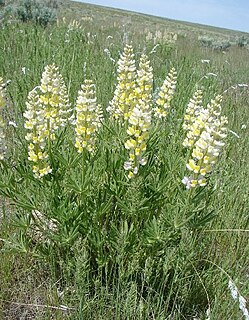
Lupinus arbustus is a species of lupine known by the common name longspur lupine. It is native to western North America from British Columbia to California to Utah, where it grows in several types of habitat, including sagebrush and forests. This is a perennial herb growing erect to a maximum of 70 centimetres tall. It is sometimes hairy in texture. Each palmate leaf is made up of 7 to 13 leaflets each up to 7 centimetres long. The inflorescence is up to 18 centimetres long, bearing whorls of flowers each up to 1.4 centimetres long. The calyx of sepals around the base of the corolla has a knoblike spur at the back. The flower corolla is white to yellow to various shades of purple or pink. The fruit is a hairy legume pod 2 or 3 centimetres long. There are several subspecies.
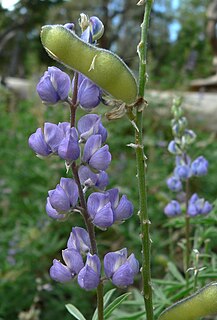
Lupinus argenteus is a species of lupine known by the common name silvery lupine. It is native to much of western North America from the southwestern Canadian provinces to the southwestern and midwestern United States, where it grows in several types of habitat, including sagebrush, grassland, and forests. This is a perennial herb growing erect to heights anywhere between 10 centimetres (3.9 in) and 1.5 metres (4.9 ft). It is sometimes silvery-hairy in texture and sometimes nearly hairless. Each palmate leaf is made up of 5 to 9 leaflets each up to 6 centimetres long. They are narrow and linear in shape, under a centimetre wide. The inflorescence bears many flowers, sometimes arranged in whorls. The flower is 5 millimetres (0.20 in) to 14 millimetres (0.55 in) long and purple, blue, or whitish in color. The banner, or upper petal, of the flower may have a patch of white or yellow. The fruit is a hairy legume pod up to 3 centimeters long containing several beanlike seeds. The plant is an important food source for butterflies. It also attracts birds and hummingbirds.
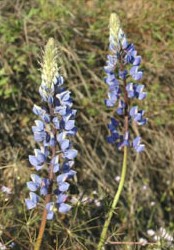
Lupinus benthamii is a species of lupine known by the common name spider lupine.
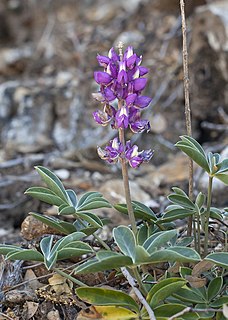
Lupinus cervinus is a species of lupine known by the common name Santa Lucia lupine. It is endemic to the Santa Lucia Mountains in the Central Coast Ranges in California, where it is an uncommon member of the flora in the mountain forests. This is a hairy gray-green perennial herb growing up to 30–70 centimetres (12–28 in) tall. The erect stem is surrounded by clusters of spreading leaves. Each palmate leaf is made up of 4 to 8 leaflets up to 8 centimetres (3.1 in) long and 3 centimetres (1.2 in) wide, which is wider than the leaflets of most lupines. The inflorescence bears many flowers, sometimes in whorls, each between 1 centimetre (0.39 in) and 2 centimetres (0.79 in) long. The flower is often bright pink, but may be shades of blue to nearly white. There is often a yellow patch on the banner. The fruit is a hairy legume pod up to 6 centimetres (2.4 in) long.
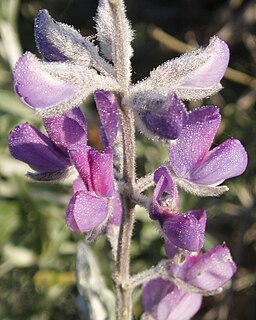
Lupinus chamissonis is a species of lupine known by the common name Chamisso bush lupine. It is endemic to California, where it is known from most of the length of the coastline. It grows in sand dunes and other immediate coastal habitat.

Lupinus citrinus is a species of lupine known by the common names orange lupine, orangeflower lupine, and fragrant lupine. It is endemic to California, where it is known from a section of the Sierra Nevada foothills extending from Mariposa to Fresno Counties. This is an annual herb growing 10–60 centimetres (3.9–23.6 in) tall. Each palmate leaf is made up of 6 to 9 leaflets up to 3.5 centimetres (1.4 in) long. The herbage is coated in tiny white hairs. The inflorescence bears several flowers, sometimes in whorls. Each flower is roughly a centimeter long and orange to yellow to white in color. The fruit is a legume pod 1 or 2 centimetres (0.79 in) long containing seeds which resemble "pieces of granite."

Lupinus flavoculatus is a species of lupine known by the common name yelloweyes, or yellow-eyed lupine.,
Lupinus lapidicola is a rare species of lupine known by the common name Mt. Eddy lupine. It is endemic to California, where it is known from only a few locations in the northernmost mountain ranges, including Mount Eddy in the Klamath Mountains. It is a small, compact perennial herb forming mats no more than 10 centimetres (3.9 in) tall. Each palmate leaf is divided into 6 to 8 leaflets up to 2 centimetres (0.79 in) long. The herbage is coated in silvery silky hairs. The inflorescence is a small bundle of flower whorls, each flower about a centimeter long and purple in color with a yellowish patch on its banner.
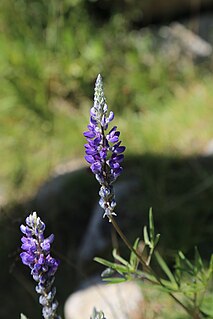
Lupinus pratensis is a species of lupine known by the common name Inyo meadow lupine. It is endemic to California, where it grows in the central Sierra Nevada and adjacent plateau and valleys to the east. It grows in relatively moist habitat, such as streambanks and spring meadows. This is an erect perennial herb growing 30–70 centimetres (12–28 in) tall. Each palmate leaf is made up of 5 to 10 narrow leaflets sometimes exceeding 10 centimetres (3.9 in) long. The leaves are borne on long petioles which can reach 25 centimetres (9.8 in) in length. The herbage is green and coated in thin hairs. The inflorescence is a dense raceme of many flowers each around a centimeter long. The flower is dark blue or purple with a reddish or orange patch on its banner. The fruit is a hairy legume pod around 2 centimetres (0.79 in) long.

Lupinus rivularis is a species of lupine known by the common name riverbank lupine native to North America. It is also commonly known as river lupine, streambank lupine, and stream lupine.
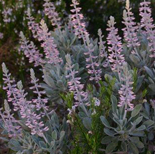
Lupinus aridorum is a rare species of lupine known by the common name scrub lupine. It is endemic to Florida in the United States, where there were 10 known populations remaining in 2003. Fewer than 6000 individual plants were counted. It is threatened by the loss and degradation of its habitat. The scrub lupine is a federally listed endangered species of the United States.
















